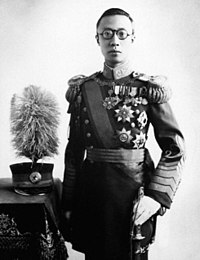Manchuguo
| Puppet state of the Empire of Japan | ||||||||||
|
||||||||||
|
Anthem National Anthem of Manchukuo |
||||||||||
|
Location of Manchukuo (red) within Imperial Japan's sphere of influence.
|
||||||||||
| Capital |
Hsinking (Changchun) (until 9 August 1945) Tonghua (Linjiang) (until 18 August 1945) |
|||||||||
| Languages |
Japanese Mandarin Mongolian Manchu (unofficial) |
|||||||||
| Government | One-party state under constitutional monarchy | |||||||||
| Chief Executive | ||||||||||
| • | 1932–1934 | Aisin-Gioro Puyi | ||||||||
| Emperor | ||||||||||
| • | 1934–1945 | Kangde (Aisin-Gioro Puyi) | ||||||||
| Prime Minister | ||||||||||
| • | 1932–1935 | Zheng Xiaoxu | ||||||||
| • | 1935–1945 | Zhang Jinghui | ||||||||
| Legislature | Legislative Council | |||||||||
| Historical era | Interbellum · World War II | |||||||||
| • | Proclaimed | 18 February 1932 | ||||||||
| • | Disestablished | August 1945 | ||||||||
| Area | ||||||||||
| • | 1934 est. | 1,554,000 km2 (600,000 sq mi) | ||||||||
| Population | ||||||||||
| • | 1934 est. est. | 30,880,000 | ||||||||
| Density | 20/km2 (51/sq mi) | |||||||||
| Currency | Manchukuo yuan | |||||||||
|
||||||||||
| Today part of |
|
|||||||||
| Manchukuo | |||||||||||||||||||||
| Chinese name | |||||||||||||||||||||
|---|---|---|---|---|---|---|---|---|---|---|---|---|---|---|---|---|---|---|---|---|---|
| Traditional Chinese | 滿洲國 | ||||||||||||||||||||
| Simplified Chinese | 满洲国 | ||||||||||||||||||||
| Literal meaning | Manchu State | ||||||||||||||||||||
|
|||||||||||||||||||||
| Japanese name | |||||||||||||||||||||
| Kanji | 満州国 | ||||||||||||||||||||
| Kana | まんしゅうこく | ||||||||||||||||||||
|
|||||||||||||||||||||
| Transcriptions | |
|---|---|
| Standard Mandarin | |
| Hanyu Pinyin | Mǎnzhōuguó |
| Wade–Giles | Man3-chou1-kuo2 |
| IPA | [mànʈʂóukwǒ] |
| Gan | |
| Romanization | Mon3 jiu1 goet6 |
| Yue: Cantonese | |
| IPA | [mʊ̬ntsɐ́ukʷɔ̄ːk] |
| Jyutping | mun5 zau1 gwok3 |
| Transcriptions | |
|---|---|
| Romanization | Manshū-koku |
| Empire of Great Manchuria | |||||||||||||||||
| Chinese name | |||||||||||||||||
|---|---|---|---|---|---|---|---|---|---|---|---|---|---|---|---|---|---|
| Traditional Chinese | (大)滿洲帝國 | ||||||||||||||||
| Simplified Chinese | (大)满洲帝国 | ||||||||||||||||
| Literal meaning | (Great) Manchu Empire | ||||||||||||||||
|
|||||||||||||||||
| Japanese name | |||||||||||||||||
| Kanji | (大)満州帝国 | ||||||||||||||||
| Kana | (だい)まんしゅうていこく | ||||||||||||||||
|
|||||||||||||||||
| Transcriptions | |
|---|---|
| Standard Mandarin | |
| Hanyu Pinyin | (Dà) Mǎnzhōu Dìguó |
| Wade–Giles | (Ta4) Man3-chou1 Ti4-kuo2 |
| IPA | [(tâ) mànʈʂóu̯ tîku̯ǒ] |
| Yue: Cantonese | |
| IPA | [(tàːi) mʊ̬ntsɐ́u tɐ̄ikʷɔ̄ːk] |
| Jyutping | (daai6) mun5 zau1 dai3 gwok3 |
| Transcriptions | |
|---|---|
| Romanization | (Dai) Manshū Teikoku |
| Emperor of Manchukuo | |
|---|---|
|
Imperial
|
|

Imperial Standard
|
|

Kāngdé
|
|
| Details | |
| Style | His Imperial Majesty |
| First monarch | Kāngdé |
| Last monarch | Kāngdé |
| Formation | 1 March 1934 |
| Abolition | 15 August 1945 |
| Residence | Imperial Palace |
| Pretender(s) | Jin Yuzhang |
Manchukuo (traditional Chinese: 滿洲國; pinyin: Mǎnzhōuguó; Japanese: 満州国; literally: "State of Manchuria") was a puppet state in Northeast China and Inner Mongolia, which was governed under a form of constitutional monarchy. The area, collectively known as Manchuria by westerners and Japanese, was designated by China's erstwhile Qing Dynasty as the "homeland" of the ruling family's ethnic group, the Manchus. In 1931, the region was seized by Japan following the Mukden Incident and a pro-Japanese government was installed one year later with Puyi, the last Qing emperor, as the nominal regent and emperor. Manchukuo's government was dissolved in 1945 after the defeat of Imperial Japan at the end of World War II. The territories formally claimed by the puppet state were first seized in the Soviet invasion of Manchuria in August 1945, and then formally transferred to Chinese administration in the following year.
Manchus formed a minority in Manchukuo, whose largest ethnic group were Han Chinese. The population of Koreans increased during the Manchukuo period, and there were also Japanese, Mongols, White Russians and other minorities. The Mongol regions of western Manchukuo were ruled under a slightly different system in acknowledgement of the Mongolian traditions there. The southern part of the Liaodong Peninsula was ruled by Japan as the Kwantung Leased Territory.
...
Wikipedia



